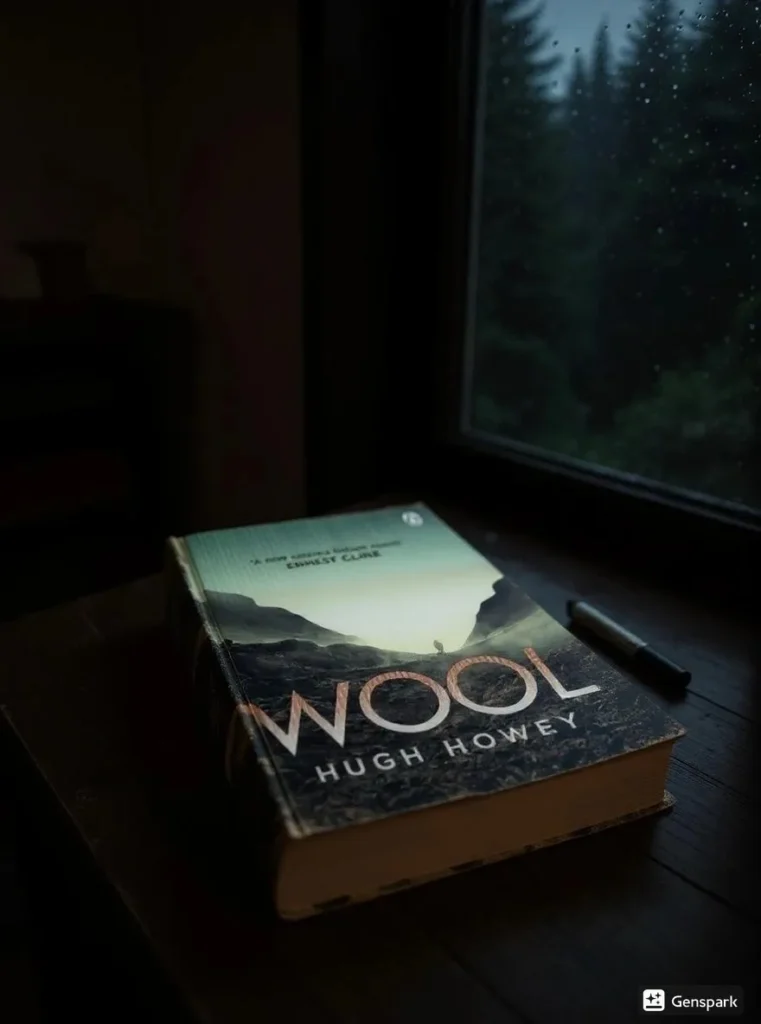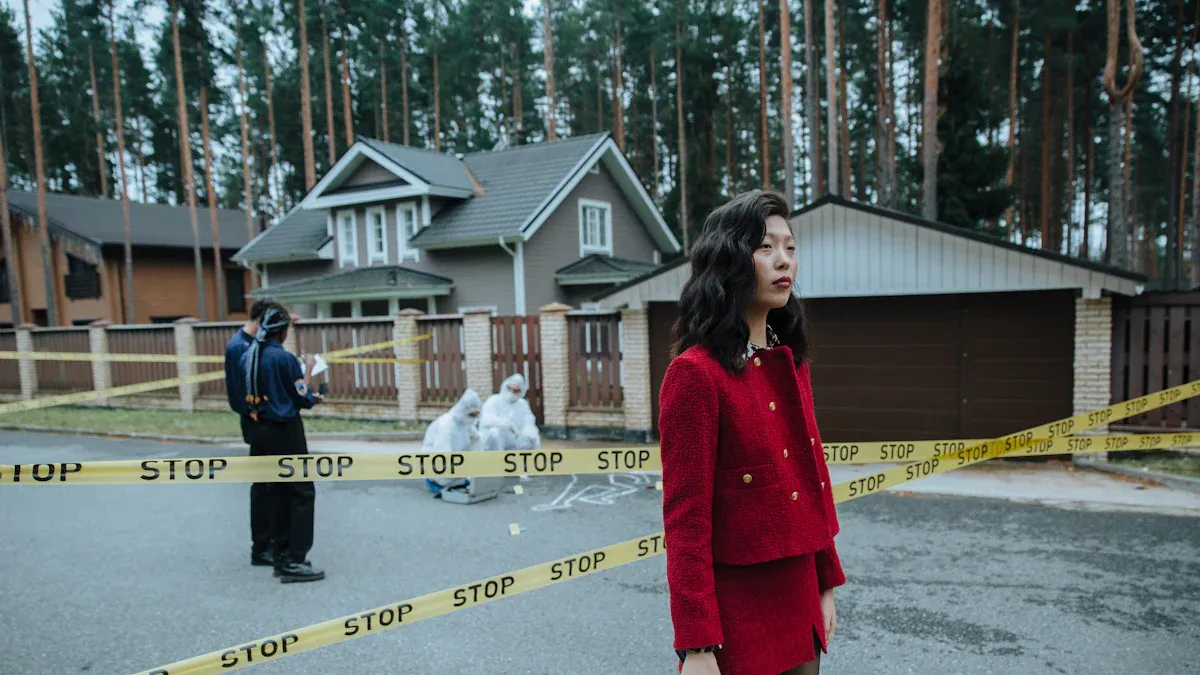I picked up Wool after hearing whispers about this underground community that made my skin crawl just thinking about it. Hugh Howey’s post-apocalyptic masterpiece started as a $0.99 e-book novella in July 2011, but trust me when I say this self-published phenomenon packs more punch than most traditionally published dystopian novels I’ve devoured in my twenty years of reviewing. What happens when curiosity about the outside world becomes a death sentence?
I’ve gotta be honest—this book grabbed me by the throat from page one and didn’t let go until 3 AM. The concept of people living in underground silos, forbidden from questioning what lies beyond their metal walls, felt disturbingly plausible in our current climate. Howey crafts a world where asking the wrong question literally gets you killed, and the psychological weight of that reality left me mentally scarred.
After walking away from several six-figure advance offers, Howey became the first self-published author ever to be offered a print-only contract by Simon & Schuster. This indie success story proves that sometimes the most gripping tales come from the most unexpected places. The book explores themes of truth, control, and rebellion with surgical precision, making it impossible to put down.
Key Takeaways
The silo’s closed-system survival depends entirely on strict adherence to rules that nobody questions, creating a society built on fear and ignorance.
Truth becomes the most dangerous weapon in a world where curiosity equals death, and those brave enough to seek answers pay the ultimate price.
The serialized format creates addictive pacing that mirrors the claustrophobic tension of underground living, keeping readers as trapped as the characters themselves.
Howey’s world-building demonstrates how easily populations can be controlled through carefully crafted lies and manufactured consent.
The psychological depth of characters like Holston and Juliette reveals how institutional trauma shapes individual choices across generations.
Basic Book Details
Publishing Information: July 29, 2011 (first Wool story), Omnibus Edition 2012 by Hugh Howey (self-published), later by Simon & Schuster
Genre: Science Fiction, Dystopian Fiction, Post-Apocalyptic
Plot: Humanity survives underground in massive silos after an apocalyptic event, but questioning the outside world means death
Series Information: Book 1 in The Silo Series (followed by Shift and Dust)
Page Count: 594 pages (Omnibus Edition)
Main Characters:
Holston: Sheriff who breaks the ultimate taboo by asking to go outside
Juliette: Mechanic turned sheriff who uncovers the silo’s darkest secrets
Marnes: Deputy sheriff caught between duty and conscience
Mayor Jahns: Leader attempting to maintain order in chaos Bernard: IT head controlling information flow with iron fist
Plot And World Building Analysis
A silo-bound society features intricate engineering and closed-system survival
Howey’s underground civilization spans 144 levels, housing ten thousand people in a perfectly engineered ecosystem. The technical details feel authentic—from the generator systems to waste management, every aspect of survival has been meticulously planned. I spent hours imagining the spiraling staircases that connect each level, the way sound travels through metal corridors, and how claustrophobic life must feel when you can never see the sky.
The author’s background shows in his mechanical precision. Every pipe, wire, and ventilation system serves multiple purposes in this closed environment. The silo isn’t just a setting; it’s a character that breathes, groans, and occasionally threatens to fail catastrophically.
Generational control and strict resource rules shape life underground
Three centuries of conditioning have created a population that polices itself through ingrained fear. The lottery system for having children, the strict job assignments, and the absolute prohibition against discussing the outside world create a suffocating social structure. Howey shows how totalitarian control doesn’t always require violence—sometimes fear of the unknown is enough.
The most chilling aspect is how naturally residents accept their limitations. When I read about families passing down the same jobs for generations, never questioning why they can’t choose their own paths, I felt physically sick. This isn’t just science fiction; it’s a mirror reflecting our own willingness to accept restrictions “for our own good.”
Character Development And Psychological Depth
Holston and Juliette’s arcs explore truth, rebellion, and sacrifice
Holston’s transformation from loyal sheriff to questioning rebel happens with heartbreaking authenticity. His wife’s death catalyzes a crisis of faith that readers feel in their bones. I found myself staying up until dawn, desperate to know if he’d find the courage to challenge everything he’d been taught. His final choice—requesting to go outside—represents the ultimate act of defiance against a system built on lies.
Juliette’s journey from mechanical expertise to political awakening demonstrates Howey’s skill with character evolution. She starts as someone who fixes things and evolves into someone who fixes systems. Her technical knowledge becomes a weapon against institutional deception, and watching her connect the dots between mechanical failures and social control gave me chills.
Side characters reflect systemic oppression and unpredictable mortality
Howey refuses to protect characters from consequences, creating genuine tension in every interaction. Mayor Jahns, Marnes, and Bernard each represent different responses to authoritarian pressure—compliance, reluctant participation, and enthusiastic enforcement. The author kills characters without warning, just like real authoritarian regimes eliminate threats.
The supporting cast feels lived-in rather than manufactured for plot convenience. Each person carries generational trauma from three centuries of underground existence, and their interactions reveal how prolonged isolation warps human nature.
Writing Style And Literary Technique
The serialized format creates fast pacing and episodic tension
Originally published as five separate stories, the omnibus edition maintains distinct narrative arcs while building toward a larger revelation. Each section ends with cliffhangers that had me frantically turning pages. Howey understood that readers needed immediate gratification while building long-term investment in his world.
The pacing feels like a controlled descent into madness. Short chapters and constant perspective shifts mirror the disorientation characters experience when their worldview crumbles. I found myself reading faster as the tension escalated, mimicking the characters’ increasing desperation.
Suspense unfolds through strategic mystery layering and reveals
Howey parcels out information like a master manipulator, giving readers just enough truth to stay engaged while withholding the big picture. The revelations about the silo’s true purpose, the nature of the outside world, and the conspiracy maintaining their imprisonment unfold with perfect timing. Each answer generates three new questions, creating addictive reading.
The author uses technical details as breadcrumbs leading to larger truths. Juliette’s mechanical discoveries become plot reveals, demonstrating how expertise in one area can illuminate corruption in another. This technique made me trust the narrative while questioning everything alongside the characters.

Genre Positioning And Comparative Analysis
A standout in dystopian fiction with classic and modern influences
Wool shares DNA with classics like 1984 and Brave New World while feeling distinctly contemporary. The underground setting recalls The City of Ember, but Howey’s adult themes and psychological complexity place it firmly in mature dystopian territory. Unlike young adult dystopias that focus on romance, Wool examines how societies maintain control through manufactured consent.
The claustrophobic setting differentiates it from surface-based post-apocalyptic stories. Where The Road or Station Eleven deal with rebuilding civilization, Wool explores preserving civilization through lies. This philosophical difference creates unique narrative possibilities that Howey exploits brilliantly.
Its self-published rise reshaped perceptions of indie sci-fi success
Howey’s success story—from $100 monthly self-publishing income to seven-figure traditional publishing offers—proved indie authors could compete with major publishers. Wool became a case study in how quality content finds its audience regardless of publishing method. The book’s organic growth through word-of-mouth recommendations demonstrated that readers crave authentic storytelling over marketing budgets.
This success opened doors for other indie sci-fi authors and forced traditional publishers to reconsider their gatekeeping role. Wool’s impact extends beyond entertainment into industry transformation, making it historically significant within science fiction publishing.
Pros
The world-building achieves rare authenticity through technical precision and psychological realism. Every mechanical detail serves the larger narrative while creating genuine claustrophobia that readers experience viscerally. Howey’s characters feel like real people making impossible choices rather than plot devices moving the story forward.
The serialized structure creates natural stopping points while maintaining momentum across the entire narrative. Each section delivers complete satisfaction while contributing to the larger arc. The pacing never drags, and the reveals are timed perfectly to maximize impact.
The philosophical questions about truth, control, and freedom resonate beyond the science fiction framework. Howey examines how easily populations accept limitations when those restrictions are presented as protection. These themes feel disturbingly relevant to contemporary political discussions.
Cons
The writing occasionally shows its self-published origins through inconsistent prose quality and repetitive phrasing. Some dialogue feels stilted, particularly during exposition-heavy scenes where characters explain world-building details. The author’s technical background sometimes overwhelms character development with mechanical descriptions.
Critics noted “Howey’s immaturity as a writer, especially the bland characters and conflict reminiscent of B-movies”. While I disagree with the harshness of this assessment, certain secondary characters do lack depth beyond their functional roles. The romance subplot feels underdeveloped compared to the political intrigue.
The ending rushes toward resolution without fully exploring the implications of the revelations. After building tension so masterfully, the conclusion feels anticlimactic. Some plot threads remain frustratingly unresolved, clearly setting up sequels rather than providing complete satisfaction.
Final Verdict
Wool succeeds as both gripping entertainment and thoughtful social commentary, despite occasional prose weaknesses. Howey created a world that feels authentic enough to be terrifying and characters compelling enough to care about deeply. The book’s exploration of truth versus security resonates powerfully in our current political climate.
I recommend Wool to readers who appreciate dystopian fiction with philosophical depth, particularly those interested in how technology enables social control. Anyone who enjoyed The Giver, Fahrenheit 451, or The Handmaid’s Tale will find similar themes explored through a fresh lens. The book works equally well as standalone reading or series introduction.
Readers sensitive to claustrophobic settings or institutional gaslighting might find the content overwhelming. The psychological manipulation depicted throughout the story can be genuinely disturbing for those who’ve experienced similar real-world situations.
At Dionysus Reviews, we’ve seen countless dystopian novels attempt what Wool achieves naturally—creating a world that feels both fantastical and uncomfortably plausible. This book belongs on the shelf next to genre classics, proving that independent authors can produce work that rivals traditional publishing houses.
Dionysus Reviews Rating: 7/10
The book combines compelling world-building with authentic character development while exploring themes that extend far beyond science fiction. Despite prose inconsistencies and pacing issues in the conclusion, Wool delivers the rare combination of entertainment and intellectual engagement that defines truly memorable literature.
Sip The Unknown—Discover Stories You Never Knew You’d Love!
Dionysus Reviews Has A Book For Every Mood
Biography & Memoir
Fiction
Mystery & Detective
Nonfiction
Philosophy
Psychology
Romance
Science Fiction & Fantasy
Teens & Young Adult
Thriller & Suspense
Frequently Asked Questions
What makes Wool different from other dystopian novels?
Unlike surface-based post-apocalyptic stories, Wool explores how societies preserve civilization through systematic deception rather than rebuilding after collapse.
The underground setting creates unique psychological pressures that surface stories can’t replicate, while the focus on institutional gaslighting rather than external threats offers fresh perspective on dystopian themes.
How accurate is the technical world-building in the silo?
Howey’s mechanical background shows in the authentic engineering details throughout the underground community. The closed-system ecology, power generation, and waste management systems feel plausible enough to support the story’s premise. Technical readers will appreciate the attention to realistic infrastructure challenges in maintaining an isolated population.
Does Wool work as a standalone read or require the full series?
The omnibus edition provides satisfying resolution to the immediate crisis while clearly setting up larger questions for subsequent books. Readers can enjoy Wool independently, though some plot threads remain deliberately unresolved. The book functions as both complete story and series introduction depending on reader preference.
How does the serialized original format affect the reading experience?
The five-story structure creates natural breaking points that maintain momentum while allowing readers to process each revelation before moving forward. This episodic approach mirrors television storytelling, creating cliffhangers that drive continued reading. The format enhances rather than disrupts the overall narrative flow.
What content warnings should readers consider before starting Wool?
The book contains themes of institutional manipulation, suicide, and claustrophobic confinement that may trigger readers with related sensitivities. Violence occurs but isn’t graphically depicted, while the psychological manipulation portrayed throughout can be genuinely disturbing. The story explores how societies control populations through manufactured fear and systematic deception.









